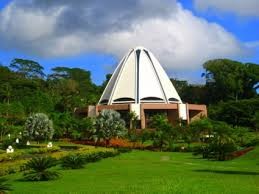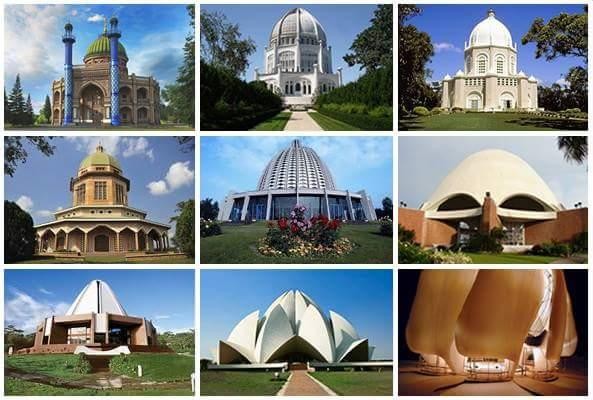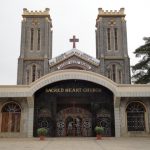The world has been divided not only in the name of nation but also in the name of religion. Baha’ullah from Persia founded Baha’i faith over a hundred and fifty years ago. 200th Anniversary of the Birth of Baha’ullah happening this year will be a big event. A really big event, with the hope of seeing ten times the number of people attending as there are Baha’is in the community. Baha’i temples are constructed in various parts of the world. They represent the essence of the faith, as visitors from all religions are welcome here to meditate . The temples offer serene atmosphere and each of these temples are uniquely designed sharing some common features. Every Baha’i temple has a central dome and nine entrances, which suggest that people from various directions gather at a common place to meditate and reflect without and inter-mediation in the form of clergy, sermons and rituals.There are seven Baha’i temples , referred to as Baha’i houses of worship, in seven continents of the world.
The Baha’i House of Worship, North America

The cornerstone for Baha’i temple in North America was laid in the year 1912 and the construction was completed in the year 1953. The stunning architecture of the temple amidst gorgeous gardens has earned it a place among the Seven Wonders of Illinois. Fountain Hall, which is the temple’s oldest part and Cornerstone Room are located in the lower level. The temple is the oldest and the largest of the Baha’i temples in the world. The intricate designs on the walls of the auditorium are awe-inspiring. From the main floor, the dome rises to 135 feet high and is amazing to look at.
The Baha’i House of Worship, Australia

Located near the northern beaches of Sydney, the Baha’i temple looks stunningly gorgeous. Spread over an area of nine hectares, the temple and the lush gardens have become one of the most frequented sites in Australia ever since it was constructed in the year 1961. The dome rises 38 meters above the floor. The gardens surrounding the temple contain unique and native plants.
The Baha’i House of Worship, Uganda

The Baha’i Temple in Uganda was built in the year 1962. It took four years to complete the construction, which began in the year 1958. Situated at Kikaaya Hill on the outskirts of Kampala, the temple, like every Baha’i temple, has unique style. The green color dome is made of mosaic tiles acquired from Italy and the tiles in the lower roof are acquired from Belgium. The glass windows add beauty to the interior with its green, white, blue and amber colors. As the nine doors open, you are captivated by the stunning interior that resembles the fields and the skies on a sunny day.
The Baha’i House of Worship, Germany

Situated in a scenic location at the foot of the Taunus mountain range in Germany, Baha’i Temple was opened in the year 1964. Covering an area of 29,068 sq. m, the temple is a stunning display of architecture. The designer Teuto Rocholl was entrusted with the job of designing the temple following an architectural competition in which his design was selected. The dome looks amazingly sun-lit thanks to the 540 diamond-shaped windows in it.
The Baha’i House of Worship, Panama

The construction of Baha’i Temple in Panama began in the year 1967 and it was completed in 1972. Perched on Cerro Sonsonate (singing hill), a high cliff, the temple resembles fabric designs of Native Americans. The dome is fabulously made with over thousands of tiles, which are oval-shaped. The entrance gates have three-dimensional designs. The temple looks like a giant-sized egg. The interior of the temple is not only beautiful but it also has fresh breeze throughout the day.
The Baha’i House of Worship, Samoa

The construction of Baha’i Temple commenced in the year 1979 in Samoa and it was completed in the year 1984. It is considered the Mother Temple of Pacific Islands. The king of Samoa Malietoa Tanumafili II dedicated the temple and he was the first reigning monarch to become a Baha’i. Spread across a sprawling 20 acres of land, the House of Worship in Samoa is well-structured striking similarity with all other Baha’i temples. The dome soars to a height of 92 feet and the main auditorium that houses the dome is exceptional. The prayer gardens house over 60 species of plants, trees and flowers.
The Baha’i House of Worship, India

Resembling the lotus flower, the Baha’i Temple in India displays the richness of imagination of the architect behind the design. Fariborz Sahba, an Iranian, was the designer of this wonderful temple in the Capital city of India. The construction was completed in the year 1986. The 27 petal like structures with three in a cluster form the nine entrances. Constructed in 26 acres of land, the temple enjoys plenty of visits.
Baha’i Temple of South America

Toronto-based Hariri Pontarini Architects’ Baha’i Temple of South America has won the 2017 Innovation in Architecture Award presented by the Royal Architectural Institute of Canada (RAIC).
Located in the foothills of the Andes Mountains outside Santiago, Chile, the domed building was designed and built using computer modeling, measuring, and fabrication software, as well as custom glass, all of which culminated in nine monumental veils that frame an open worship space for up to 600 visitors. Completed in 2016, the project took 14 years to realize.









